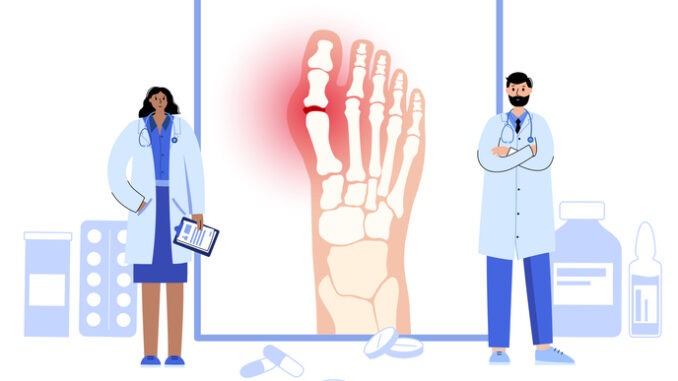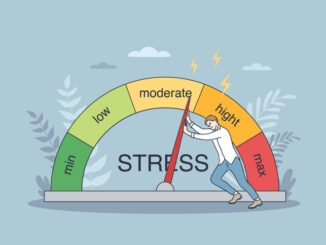
Mention gout and, for many, the image of a bewigged, obese, plethoric, Regency fop attired in frock coat, pantaloons and rufflettes, holding a glass of port comes to mind. He sits slouched in a grand armchair, his foot, bandaged for protection, on a cushion. Perhaps the historic archetype, but what about now? Dr Paul Lambden explores
Gout is a form of arthritis which occurs as a result of the build-up of crystals of uric acid in and around a joint or joints. The uric acid levels rise in the blood and it precipitates in crystal form. It is true that the big toe (metatarso-phalangeal joint) is the most common site for the problem but other joints can be involved too; these include the knees, hips and the joints of the arm and hand.
Although the first attack normally involves one joint, subsequent attacks may affect several joints, a condition called polyarticular gout. The joint may be exquisitely painful, as well as swollen, and the skin overlying the joint becomes purplish-red and shiny.
The disorder occurs three or four times more frequently in men. The first attack is commonly between the ages of 30 and 50; 20% of patients have a family history of gout. The risk is increased in people with obesity, hypertension, kidney disease, diabetes and those who drink too much beer or spirits or who eat excess sardines or liver (which contain high purine levels). Sufferers of psoriasis are also more prone to the disease.
Crystals of the sodium urate appear like needles in sufferers and may take months or years to accumulate in the joint. The process is symptomless; suddenly the person will develop severe pain in the joint. Sometimes the joint becomes so painful that it is impossible to walk, or to cover the joint at night. The attack may also be accompanied by a fever.
Joint pain may be accompanied by the development of lumps called tophi under the skin, often of the fingers. Each attack, typically, lasts seven-to-10 days without treatment and, after that time, symptoms subside and the joint feels largely normal again.
Diagnosis
The diagnosis of gout involves finding increased levels of uric acid in the blood, although some patients with raised uric acid never have an attack of gout, and a few patients get gout without a raised blood uric acid. Sometimes, especially if the diagnosis is in doubt, fluid can be aspirated from the affected joint and examined under the microscope to look for the classic urate crystals. In some cases, the appearance of the joint is so characteristic that, without any evidence of other forms of arthritis, the diagnosis can be made without blood tests.
Treatment
The treatment of gout may involve a mixture of self-help measures, together with medication as required. In the event of an acute attack, the symptoms may be relieved by:
- Avoiding any activity which aggravates the symptoms.
- Elevating the joint.
- Keep the joint cool.
- Not covering the joint.
- It may help to ice the joint, either using an ice-pack or, as a pragmatic alternative, the proverbial bag of frozen peas wrapped in a towel.
For the less severe attacks simple analgesia may be sufficient. Paracetamol is unlikely to be sufficient but a non-steroidal anti-inflammatory drug (NSAID), which can be purchased at the chemist, may help. For more severe symptoms, the GP may prescribe a higher-dose NSAID, such as naproxen, to be taken over a seven-to-ten day period. The use of the drug may be combined with a prescription for a medicine called a proton pump inhibitor, such as omeprazole, which protects the stomach from any irritation by the NSAID.
Alternative treatment may be with a medication called colchicine. If that is not tolerated, then a steroid (prednisolone) may be prescribed instead. With the use of the prescribed treatments, the pain in the joint normally eases within two or three days.
People who make lifestyle changes to reduce the risk of recurrence of gout – such as losing weight or altering the diet to reduce purine rich foods (such as liver, kidney, sardines and herrings, some seafood and Marmite) – may avoid further attacks. However, those people who suffer two or more attacks a year, can take a medication that controls blood uric acid levels and prevents or reduces further attacks.
The most commonly used medication to prevent gout is allopurinol, which is taken every day. For some people it may cause side effects, and other drugs are available as an alternative, such as febuxostat. Drugs such as allopurinol should not be started during an acute attack of gout because they might cause an exacerbation of the symptoms. The prescription should normally be started at least two weeks after the symptoms of an acute attack have completely subsided.



Be the first to comment